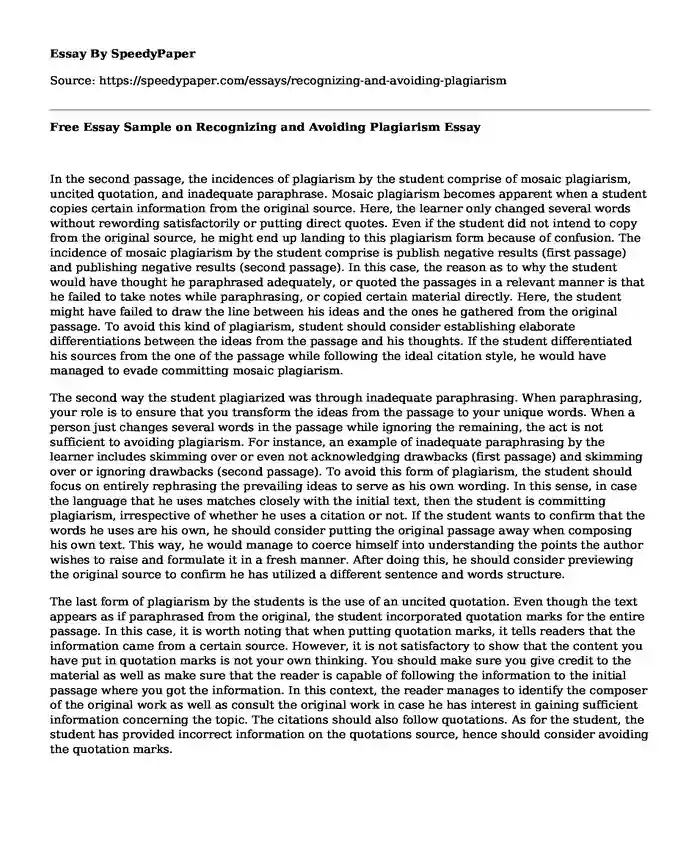In the second passage, the incidences of plagiarism by the student comprise of mosaic plagiarism, uncited quotation, and inadequate paraphrase. Mosaic plagiarism becomes apparent when a student copies certain information from the original source. Here, the learner only changed several words without rewording satisfactorily or putting direct quotes. Even if the student did not intend to copy from the original source, he might end up landing to this plagiarism form because of confusion. The incidence of mosaic plagiarism by the student comprise is publish negative results (first passage) and publishing negative results (second passage). In this case, the reason as to why the student would have thought he paraphrased adequately, or quoted the passages in a relevant manner is that he failed to take notes while paraphrasing, or copied certain material directly. Here, the student might have failed to draw the line between his ideas and the ones he gathered from the original passage. To avoid this kind of plagiarism, student should consider establishing elaborate differentiations between the ideas from the passage and his thoughts. If the student differentiated his sources from the one of the passage while following the ideal citation style, he would have managed to evade committing mosaic plagiarism.
The second way the student plagiarized was through inadequate paraphrasing. When paraphrasing, your role is to ensure that you transform the ideas from the passage to your unique words. When a person just changes several words in the passage while ignoring the remaining, the act is not sufficient to avoiding plagiarism. For instance, an example of inadequate paraphrasing by the learner includes skimming over or even not acknowledging drawbacks (first passage) and skimming over or ignoring drawbacks (second passage). To avoid this form of plagiarism, the student should focus on entirely rephrasing the prevailing ideas to serve as his own wording. In this sense, in case the language that he uses matches closely with the initial text, then the student is committing plagiarism, irrespective of whether he uses a citation or not. If the student wants to confirm that the words he uses are his own, he should consider putting the original passage away when composing his own text. This way, he would manage to coerce himself into understanding the points the author wishes to raise and formulate it in a fresh manner. After doing this, he should consider previewing the original source to confirm he has utilized a different sentence and words structure.
The last form of plagiarism by the students is the use of an uncited quotation. Even though the text appears as if paraphrased from the original, the student incorporated quotation marks for the entire passage. In this case, it is worth noting that when putting quotation marks, it tells readers that the information came from a certain source. However, it is not satisfactory to show that the content you have put in quotation marks is not your own thinking. You should make sure you give credit to the material as well as make sure that the reader is capable of following the information to the initial passage where you got the information. In this context, the reader manages to identify the composer of the original work as well as consult the original work in case he has interest in gaining sufficient information concerning the topic. The citations should also follow quotations. As for the student, the student has provided incorrect information on the quotations source, hence should consider avoiding the quotation marks.
Cite this page
Free Essay Sample on Recognizing and Avoiding Plagiarism. (2019, Oct 24). Retrieved from https://speedypaper.net/essays/recognizing-and-avoiding-plagiarism
Request Removal
If you are the original author of this essay and no longer wish to have it published on the SpeedyPaper website, please click below to request its removal:
- Patient-Centered Medical Home, Free Essay
- Essay Example: Alcohol Awareness Month
- Real-Time Reporting in Business, Essay Sample for You
- African Americans Following Reconstruction, Essay Example for You
- Technology Effect on Discourse, Free Essay
- Essay Sample on Gender Conformity and Norm-Violation
- Archetypes and Dreams - Free Paper Example
Popular categories





